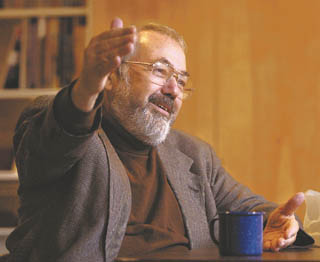|
|
Canku Ota |
|
|
(Many Paths) |
||
|
An Online Newsletter Celebrating Native America |
||
|
October 5, 2002 - Issue 71 |
||
|
|
||
|
Lecture Tells Indians' Side of History |
||
|
by Donna Healy Billings
Gazette Staff
|
||
|
credits:Larry Mayer/Gazette
Staff
Herman Viola, curator emeritus of the Smithsonian Institution |
 Crowds
mobbing the train stations astonished the legendary Sioux Chief Red Cloud
as he led a delegation of Sioux and Cheyenne to Washington, D.C., in 1870. Crowds
mobbing the train stations astonished the legendary Sioux Chief Red Cloud
as he led a delegation of Sioux and Cheyenne to Washington, D.C., in 1870.
The delegation doubted that so many white people could exist in the world. They surmised that white people packed up their cities the way tribes packed up their tepees and were following the train car from one city to the next. In Washington, D.C., tribal delegations often witnessed the full might and muscle of the fledgling nation. One treaty delegation was shocked by a tour of the city's arsenal. "It was like walking in a forest of guns," one delegate said. The tour was meant to be intimidating, said Herman Viola, curator emeritus of the Smithsonian Institution. Until the Civil War, no American Indian chief who had visited the nation's capital as a treaty delegate had ever waged war against the United States. The federal government realized it was cheaper to make friends, or to intimidate enemies, than to wage war. On Thursday, Viola gave a free slide lecture at the Western Heritage Center based on his book, "Diplomats in Buckskin." The book traces the clash of cultures, which played out in the nation's capital, as American Indians tried to defend tribal interests through diplomacy. The diplomats' story has often been overshadowed by the public's fascination with the bloodshed of the Plains Indian Wars, he said in an interview at the Western Heritage Center Tuesday. Viola, a small man with a bushy beard, relates history with the fluency of a gifted storyteller. In treaty negotiations, tribal delegations and government negotiators were as unevenly matched as they were in war. "From the start, the cards were really stacked against them," Viola said. The colonists who landed in Jamestown, Va., the first permanent English colony in the new world, tried their own version of ethnic cleansing in 1623. Settlers concluded peace negotiations by proposing a toast with drinks laced with poison. One colonist bragged about the incident in a letter to his brother in England, claiming that the poison killed 200 Indians. In Washington, negotiators sometimes cut dirty deals and exerted psychological pressure. "There are lots of examples of Indians thinking they made an agreement for one thing and when the agreement was put in writing, it was another thing," Viola said. The Indians negotiated without lawyers and relied on the rough translations of interpreters. It was the late 19th century before Indians were allowed to seek legal advice, Viola said. Although serving alcohol to Indians in Indian country was illegal, Washington negotiators plied Indian delegates with alcohol. Government documents record enormous liquor bills. Some treaties involved outright fraud. Georgia was so eager to rid the state of Indians that the state's negotiators cut a deal with four Cree chiefs who represented a single clan. Before the legitimate delegation arrived in Washington, the Senate ratified the bogus treaty. John Quincy Adams, who signed the treaty, described in his diary the enormous pressure exerted by the Georgia delegation. The leader of the legitimate delegation was so distressed that he tried to kill himself in his hotel room, Viola said. The delegation reluctantly signed a second treaty that required two-thirds of the tribe to leave Georgia. "Diplomats in Buckskin," like Viola's book, "Little Bighorn Remembered: The Untold Indian Story of Custer's Last Stand," offers the Indian perspective on events. "The most important thing people have to realize is there are two sides to every story, and the Indian side has never been told fully," he said. Viola, who was the Director of the National Anthropological Archives from 1972 until 1987, has written dozens of publications on American Indians and the American West. He is now consulting on an abridged edition of the Lewis and Clark journals and writing the story of a Masai warrior from Kenya who was the first member of his tribe to go to school. The Masai tribal member teaches school in Falls Church, Va., where Viola's wife also works. |
|
|
||
|
|
||
| Canku Ota is a free Newsletter celebrating Native America, its traditions and accomplishments . We do not provide subscriber or visitor names to anyone. Some articles presented in Canku Ota may contain copyright material. We have received appropriate permissions for republishing any articles. Material appearing here is distributed without profit or monetary gain to those who have expressed an interest. This is in accordance with Title 17 U.S.C. section 107. | ||
|
Canku Ota is a copyright © 2000, 2001, 2002 of Vicki Lockard and Paul Barry. |
||
 |
 |
|
|
The "Canku Ota - A Newsletter Celebrating Native America" web site and its design is the |
||
|
Copyright © 1999, 2000, 2001, 2002 of Paul C. Barry. |
||
|
All Rights Reserved. |
||